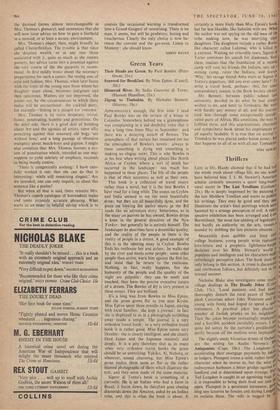Thrillers
In
Nicholas Blake also investigates some mor-
village dealings in The Deadly Joker (Cri0 Club, 15s.). 'Local passions and bad blood thoroughly disturb the rural peace of Nether,' 0'1 plash Cantorum where John Waterson and 11h, young wife Jenny had hoped to spend a 01' retirement. A practical joker has played 3 ti number of foolish pranks on his neighbour Then the jokes become increasingly unpleasant (l- and a horrible accident inevitably occurs. I vd quite led astray by the narrator's predilection' ki partly because all the motives seem implausible'
The slightly seedy Victorian streets of Duiviicli str
are the setting for Austin to Stevens's Antagonists (Cape, 18s.). The Langdons '1" accelerating their mortgage payments by tall t in lodgers. Plumpett seems a mild, rather lovallid character when he moves in, but the wiry 0,5 railwayman harbours a bitter grudge against 111( landlord and is determined upon revenge. Pcfr Ted Langdon is caught in an agonising trap, 'h°i it is impossible to bring their feud out into 1'17, open. Plumpett is a persistent tormentor, grad bing any luxuries he fancies and daring Lange; to reclaim, them.. The wife is nagged by 11 LATE in life, Hardy claimed that if he had told the whole truth about village life, no one would have believed him. J. 1. M, Stewart's American scholar certainly uncovers a queer long-buried rural secret in The Last Tresilians (Gollanci; 21s.). He is deeply impressed by the painting of the late Matthew Tresilian and wants to publish , his writings. They may be good and they may illuminate the artist's final paintings which see haunted by a strange perception of evil. A retr' I spective exhibition has been arranged and Lor.1 ' Burntisland, 'the most law-abiding of legislators. but hardly an authority on the arts, causes 3 1
scandal by dubbing the late pictures obscene. f
Meanwhile dons quibble and feud over ' college business, young people write rapturous v love-letters and a .prophetic lighthouse-keePef 1 declaims over his Bible. Stewart's world 1' f', populous and intelligent and his characters mak, j ' refreshingly perceptive jokes. The book does 110; only belong to this section. A crime is discovered " and retribution follows, but definitely not in the I' normal manner.
slummy habits and disrespect for her property: he drapes the room with washing lines and his cage-birds mess the furniture. The whole desperate situation—from the fluttery, social- climbing wife, to the drab, determined pensioner —is immensely plausible and gains in sinister effectiveness for this reason.
The Catfish Tangle (Cassell, 15s.) is Charles Williams's new contribution to suspense litera- ture. It literally tingles with tension as hero Jack Marshall flounders ever deeper in a mire of complicated moves and counter-moves. Like many another who is caught in the grip of Passion, he acts first and thinks afterwards. An unkempt beauty going mad with loneliness is the Pivot of his scheming. Having killed her husband to a fit of panic, he devises an elaborate disap- pearing trick through which they hope to escape together to a completely new life. Inevitably he ignores one vital aspect of the plan. Patrol cars scream along the highways and former friends Ore bullets in cold blood as this gripping tale reaches its tragic climax.
Attacking Colin Wilson is no sport when he has been hit so hard and so often. Indeed The World of Violence (Gollancz, 21s.) is something of an outsider here since it is not a straight crime
It but an expository work cast in novel form. tt investigates the narrator's love-hate attitude towards violence. He is a mathematical prodigy and therefore considers himself a superior being. In childhood he learns wisdom from various mad uncles who possess a lofty and dark insight into the world. Later he tests his theories while remaining aloof from normal human attach- olents. Wilson's admirers must share his earnest conscientiousness in the pursuit of the obvious. But while the ideas here are commonplace, the narrative is quite amusing though it shows a sad lack of vigour when set against the packed pages of an ordinary thriller.
Tell it to the Birds (Hale, 12s. 6d.) is the enig- Matic title of the latest James Hadley Chase. A foolish young amateur crook lets a red-headed Woman make a fool out of him. He thinks he .can swindle the insurance company he works 'or but omits to take the most elementary pre- cautions. From a privileged position within the Company he watches powerless as the trail of evidence leads inexorably towards him. It's fun see the investigators piecing the puzzle to- tether, but the characters themselves are rather uninteresting. A fairly gruesome sex-murder is included for salacity-seekers.
In Girl Found Dead by Michael Underwood Macdonald, 12s. 6d.) an ex-cop feels entitled to chivvy -along the investigations into his own laughter's death. The sleuths resent such cleddling interference until they recognise the irtues of distraction.
The Snake is Living Yet by Susan Gilruth 'Iodder, 16s.) is a cheerful puzzle story in Which one remains fairly uninvolved with the killer or the victim. Holidaymakers and residents j I 11 Tangier are confronted with a number of orange incidents. Liane's curiosity compels her o stick around despite warning hints and an ominously mounting hotel bill. Though she is rather a foolish sleuth, the slim young detective is grateful for her help and it looks as if he may
able to solve her emotional problems in return.
The and cool, almost classical in form, is Thi4e Lately Deceased by Bernard Picton (Herbert ,enkins, 13s. 6d.). Subject, verb, object, police `111d killer. A few more qualifying clauses would nice, but the action goes round and round tkstead.
ANTONIA SANDFORD.































 Previous page
Previous page